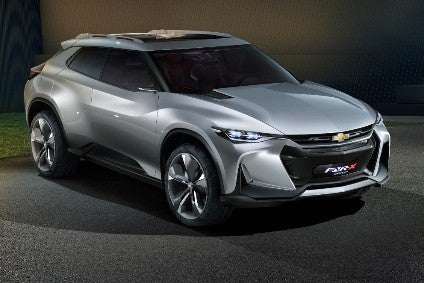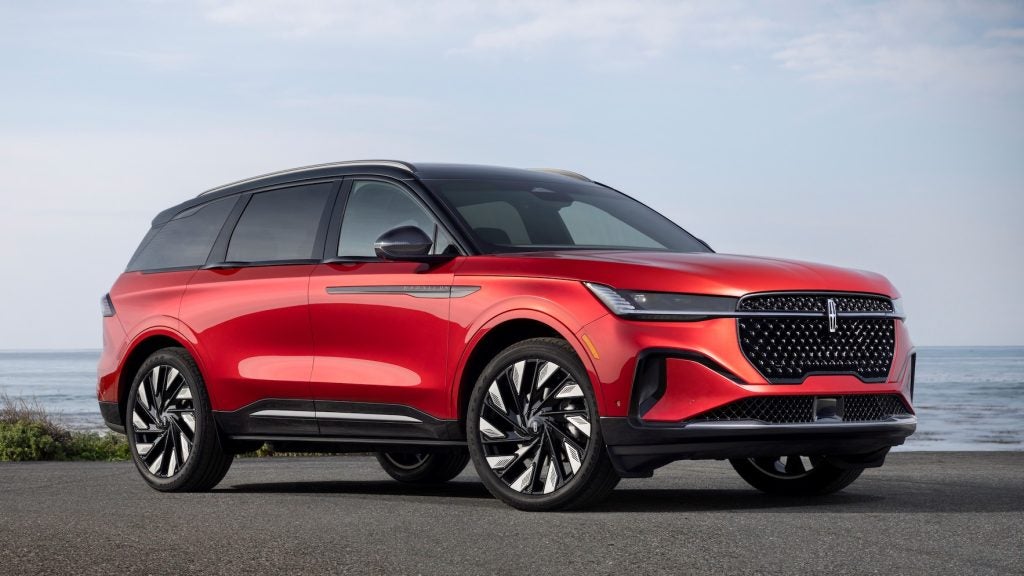
The final instalment in a series which has looked at the current and future vehicles of General Motors now goes under the skin of Chevrolet division’s light trucks.
Crossovers & SUVs
How well do you really know your competitors?
Access the most comprehensive Company Profiles on the market, powered by GlobalData. Save hours of research. Gain competitive edge.

Thank you!
Your download email will arrive shortly
Not ready to buy yet? Download a free sample
We are confident about the unique quality of our Company Profiles. However, we want you to make the most beneficial decision for your business, so we offer a free sample that you can download by submitting the below form
By GlobalDataOne of the oldest models still sold by General Motors anywhere is the Chevy Niva. This Russian and Kazakhstani-built small 4×4 has been in production since the late 1990s. It was last updated in July 2004. At that time, the main change was the arrival of an Opel 1.8-litre engine.
The March 2015 announcement by GM that it would idle two Russian plants and withdraw the majority of its Chevrolet models from the Russian market did not affect output of the current Niva, which is a rugged ladder frame SUV. Production takes place at both AvtoVAZ’s Togliatti works and at Asia Auto’s Ust-Kamenogorsk plant in Kazakhstan.
The next Niva has been delayed multiple times. A prototype will likely make its world premiere at the Moscow motor show in September. A preview was revealed at the 2014 Moscow motor show in the form of the NIVA concept. The vehicle has been under development by General Motors, not AvtoVAZ, even though it will be made alongside various Ladas at Togliatti. Production will probably last for at least ten years.
While the Niva is restricted to CIS and certain European countries, the similarly sized Trax (Trax Chuangku in China, and Tracker in some markets) is far more of a worldwide SUV. It is closely related to the Opel & Vauxhall Mokka X and Buick Encore. It has been built alongside those vehicles at a GM Korea plant since December 2012. Production of a Holden-badged version of the Trax takes place at the same Bupyeong plant. GM also makes the Trax at a factory in Mexico. Vehicles have been exported from there to Brazil since October 2013 – the Brazilian market model has a 1.8-litre flex fuel engine and is sold as the Chevrolet Tracker.
The Chevrolet Trax’s global debut was at the Paris show in September 2012. The vehicle’s styling is loosely based on the Trax concept from April 2007’s New York motor show.
The Trax has been sold in Canada and Mexico since CY2012 but originally, it was not offered in the US. The vehicle was then added to Chevrolet’s US market range for the 2015 model year, from early 2015. A facelifted Trax premiered at the Chicago auto show in February 2016. This is North America’s 2017 Trax. It arrived at dealerships in October 2016.
China’s SAIC GM joint venture began building the localised Trax Chuangku in March 2014. This model had its world premiere at the Beijing motor show the following month and went on sale immediately afterwards. A facelifted model premiered at the Guangzhou motor show in November 2016.
G2UC, the replacement for the Trax/Tracker/Chuangku, should use GM’s G2XX architecture. It is due for release worldwide from 2019. The FND-X concept (see image) was likely a preview of the styling.
One size up from the Trax is the Equinox. The latest generation model was revealed to the media in September 2016. The public saw it for the first time at the LA auto show two months later.
This Compact/C segment SUV was previously sold mainly in North American markets but it also became a model for China in its latest generation. The Equinox has been manufactured by the SAIC GM joint venture on a new line at these firms’ Wuhan plant since March. The vehicle’s public debut was at the Shanghai motor show.
GM Canada announced at the Toronto auto show in February 2015 that the CAMI plant in Ontario would again build the then next model. It is five inches (13cm) shorter so as to make room in the Chevrolet range for a new, and additional additional SUV above it and below the Traverse. The 2018 Equinox is also 180kg (400 pounds) lighter and an inch lower than the previous model. Length is 4,652mm, width is 1,843mm and height is 166mm.
Gone are the previous Equinox’s large capacity four- and six-cylinder engines, and in their place, three turbocharged four-cylinder units. GM’s Hydra-Matic 9T50 nine-speed automatic transmission is also new for the 2.0-litre variants. This gearbox for front-wheel drive & AWD cars is built by GM at its San Luis Potosi transmission plant. The 2018 Equinox for North America comes with three engine choices: 1.5-litre petrol, 2.0-litre petrol and 1.6-litre diesel.
GM began deliveries of the 2018 Chevrolet Equinox to North Americans dealerships in March, with the 2.0-litre turbo and 1.6-litre turbo diesel added three months later. There should be a facelift in 2021 and an Equinox replacement in 2025.
Another Compact Chevrolet is the much older Captiva, which is now in its final months of production. This SUV had its debut at the Geneva show in February 2006, with left-hand drive European sales following four months later. Though the Opel/Vauxhall Antara was virtually identical, both vehicles were for some years sold in Europe.
The Saturn Vue was also closely related to the Captiva – build of that model ceased in 2009. GM, however, still makes this vehicle in and for Mexico but now it is badged as the Captiva Sport (there are exports to Brazil and, between the third quarter of 2011 and September 2014, to the USA). In the US market, the Captiva Sport was available for fleet order only.
Captiva assembly by Azia Avto at its plant in Ust-Kamenogorsk, eastern Kazakhstan, commenced in June 2007. This model was also the first product for GM’s Shushary plant in Russia, with build starting there in November 2008. A separate, temporary facility started small scale Captiva assembly in St Petersburg in September 2006. Assembly in Kaliningrad by AvtoTOR started in February 2012.
GM China began selling the Captiva during 2011 (imported from GM Korea). Assembly at Shanghai GM’s Shenyang plant followed in December 2011. Build in China ceased in late 2016.
A facelifted Captiva premiered at the Geneva motor show in March 2013. Yet another facelift went on sale in South Korea in December 2015 with the equivalent Holden version following soon after. There is no direct Captiva replacement.
To be sized above the Equinox and below the ladder-frame TrailBlazer, the future Blazer will be a five-occupant SUV. This additional vehicle will effectively be a short-wheelbase Chevy Traverse and a rival for the Ford Edge. The Blazer name dates to 1969 and GM would do well to revive it, given how well known it is.
Production could be at one of the two Ramos Arizpe plants in Mexico or else at Lansing/Delta Township in Michigan or else Spring Hill, Tennessee. The Blazer is due for release in North America for the 2019 model year and it should use the C2xx front- and all-wheel drive architecture.
The Traverse is a large crossover sold mainly in North America. The current generation model had its world debut at the Detroit auto show in January, new for North America’s 2018 model year and on sale from October. GM is trying to make this vehicle more profitable: it has added sports RS and luxury High Country trim levels.
Seating is for up to eight occupants and the standard engine for all variants with the exception of the RS is a 3.6-litre normally aspirated V6 linked to a nine-speed automatic transmission. For the RS, there is a turbocharged 2.0-litre four-cylinder engine which has more torque than the V6.
Both front- and all-wheel drive Traverse variants are offered. The life cycle should be nine years with two facelifts: one in the second quarter of 2021 and the second in late 2023.
In the D/E segment, Chevrolet has the seven-seater TrailBlazer. This body on frame SUV had its global debut at the Dubai motor show in pre-production form in November 2011. The vehicle is a five-door 4×4 version of the Colorado pick-up (see below). The production model followed at the Bangkok show in March 2012.
Following its June 2012 launch in Thailand, the TrailBlazer was rolled out to other countries in the Asia-Pacific region, as well as markets in the Middle East. A vehicle was displayed at the Moscow motor show in August 2012. There is a right-hand drive version for South Africa and India as well as another one for Australia (formerly Holden Colorado 7 but since October 2016, Holden Trailblazer).
The Trailblazer was launched with a 2.8-litre Duramax four-cylinder diesel engine. In Brazil, there is also a 3.6-litre petrol V6. GM do Brasil began building the TrailBlazer from November 2012. GM Russia commenced SKD assembly of the model at its St Petersburg plant, meanwhile, in April 2013. However, that plant was idled in mid 2015.
The next news should be a facelift during 2018. This should be followed by a next generation TrailBlazer in 2020 or 2021.
K2UC is the model code for the Tahoe, a full-sized SUV. The current model, new for North America’s 2015 model year, was revealed at a media event in September 2013 and entered production at Arlington Truck during the final quarter of that year. Sales began in North American markets from the first quarter of 2014.
The Tahoe, along with what is effectively the long wheelbase version – the Chevrolet Suburban – was the first vehicles in its segment to offer a front-seat centre air bag (bucket-seat versions). This was developed so as to provide additional protection for drivers and front passengers in far-side impact crashes, where the affected occupant is on the opposite, non-struck side of the vehicle.
The standard engine is General Motors’ 355hp 5.3-litre EcoTec3 V8 (L83). This is mated to a Hydra-Matic 6L80 six-speed automatic transmission, featuring TapShift control, Tow/Haul mode and Auto Grade Braking. There were only minor updates for the 2016 model year. The same applied for the 2017 model year.
GM has added a sports RST (Rally Sport Truck) variant for the 2018 model year. The RST has unique 22-inch wheels, a Borla exhaust system, larger Duralife brake rotors and Brembo brake pads and retuned Magnetic Ride Control suspension. GM’s L86 6.2-litre V8, paired to the 10L80 ten-speed automatic gearbox, is optional.
The next Tahoe is almost certain to use the T1xx architecture as its basis. It should again be powered by V8 gasoline engines, while the 10L80 ten-speed automatic gearbox could well become standard. Production of this full-size aluminium-bodied SUV is expected to again be at Arlington Truck in Texas.
The larger Suburban is, like the Tahoe, a body-on-frame design. As with its smaller brother, the current model entered production in late 2013 for North America’s 2015 model year. The Suburban is effectively a long wheelbase Tahoe. The GMC Yukon is the twin of the Tahoe and the Yukon XL is twinned with the Suburban.
The standard engine is General Motors’ 355hp 5.3-litre EcoTec3 V8 (L83). This is mated to a Hydra-Matic 6L80 six-speed automatic transmission, featuring TapShift control, Tow/Haul mode and Auto Grade Braking. There were only minor updates for the 2016 model year. The same applied for the 2017 model year. An RST variant is new for the 2018 model year. A facelift is due for the 2019 model year.
The next Suburban will use GM’s T1XX architecture and should start coming down the line at Arlington Truck in the final quarter of 2021. Its project code is T1YC. While the vehicle’s size is not expected to shrink, the new model should be significantly lighter thanks to weight savings incorporated in the aluminium body panels, powertrains and architecture. An eight-year life cycle is expected. It would be surprising if T1YC was not being developed with the capability for PHEV and EV applications.
Pick-ups
Chevrolet division’s littlest pick-up has been around since late 2010. S4203, the second generation Montana, was revealed to the media in Brazil in September 2010. Sales started in early 2011. There, it competes with the Fiat Strada and Volkswagen Saveiro. A van variant, the Combo, was added for the Brazilian market in December 2012.
A right-hand drive pick-up for South Africa, the other country where the first generation model was made, followed in December 2011. Whereas the old model was the Chevrolet Corsa Utility in South Africa, the current vehicle is the Chevrolet Utility. In that market, there is a diesel variant too.
In Brazil, the Montana is powered by a 1.4-litre FlexFuel engine. A (Brazilian-built) variant for Mexico, the Tornado, was announced by GM Mexico in February 2011.
The Montana/Tornado was the second vehicle in GM’s Viva project. The Chevrolet Agile, a small five-door hatchback built in Argentina, was the first. The next generation model, due for release in Brazil during 2019, is expected to be based upon the GM-SAIC architecture which was announced in July 2015.
Positioned above the Montana/Tornado and below the Silverado is the Colorado/S10. Production of this body-on-frame pick-up began at GM’s Rayong plant in Thailand in October 2011 and at a plant in Brazil in February 2012. The vehicle is sold not only in Asia, Europe and Brazil but has been exported from Thailand to Australia as a Holden since early 2012. It was also revealed to the Russian car-buying public at the Moscow motor show in August 2012.
According to GM, the current shape Colorado, which is sold in some 60 markets, was developed in Brazil. In that market, and in Mexico, the model is sold as the Chevrolet S10. The model for Brazil had a mid-life facelift in May 2016.
US production takes place at the Wentzville plant which already built GM’s full sized vans, the Chevrolet Express and GMC Savana (see below).
North America’s model premiered at the LA auto show in November 2013. The 2015 Colorado was introduced as a crew cab or an extended-cab, with a work truck, LT and the off-road capable Z71 trims available. The extended cab comes with a six-foot bed; crew cabs come with either a five- or six-foot bed.
Diesel versions of the US-built Colorado, and its twin the future GMC Canyon, were added for North America’s 2016 model year. Mexico’s 2016 model year S10, meanwhile, was announced in August 2016.
In Thailand at least, the Colorado is available in 26 different combinations of powertrains and bodystyles. These include single-cab, extended-cab and crew cab variants, wide and narrow-body options, plus low or high stance. There is a choice of 2.5- and 2.8-litre Duramax four-cylinder diesel engines.
The Isuzu D-Max which was announced just days after the new Colorado is closely related to the Chevrolet, as is the GMC Canyon.
The Chevrolet TrailBlazer, meanwhile, is an SUV variant of the current Colorado.
An off-roading variant, the Colorado ZR2, had its world premiered at the LA auto show in November 2016.
The next generation Colorado/S10 is due out in either 2020 or 2021.
The Silverado is Chevrolet’s biggest selling model both in North America and worldwide. General Motors revealed the current generation of this big pick-up and its twin, the 2014 GMC Sierra, to the media in December 2012. The public debut followed a month later at the Detroit auto show. The model name is Cheyenne in Mexico.
GM commenced production of the 2014 Silverado (and GMC Sierra) crew cabs in May 2013: the previous models accounted for more than 60 per cent of its truck volume. Build of other cab styles followed later in 2013. Engineering changes over the previous shape trucks included an aluminium hood, more high-strength steel in the body, a new frame, and electric power steering.
There are three engines, each of which is branded EcoTec3. The base unit is a 285hp 4.3-litre V6. There are also 355hp 5.3-litre and 376hp 6.2-litre V8s, part of GM’s fifth generation small block family. A six-speed automatic gearbox was carried over but an eight-speed unit was new for 2015 model year trucks with the 6.2-litre V8. It was also made standard on 6.2-litre versions of the 2015MY GMC Sierra and GMC Yukon Denali/Yukon XL Denali. The GM-developed Hydra-Matic 8L90 eight-speed is approximately the same size and weight as the Hydra-Matic 6L80 six-speed automatic, General Motors says.
An upscale trim level for the Silverado became available from October 2013: High Country. This is a natural rival for the Ford F-150 King Ranch. The Silverado High Country is distinguished by body-coloured bumpers; chrome-effect for the grille, body side mouldings, mirrors and door handles; 20-inch mirror-finish alloy wheels and 275/55 R20 all-terrain season tyres.
Wheelbases are as follows: Regular Cab with 6′ 6″ box: 119″ / 3,023mm Regular Cab with 8′ box: 133″ / 3,378mm Double Cab with 6′ 6″ box: 143.5″ / 3,645mm Crew Cab with 5′ 8″ box: 143.5″ / 3,645mm Crew Cab with 6′ 6″ box: 153″ / 3,886mm
The first 2014 Chevrolet Silverados and 2014 GMC Sierras were in US showrooms from July 2013.
GM says that due to low sales of the former Silverado & Sierra 1500 Hybrids, these variants were not replaced.
The 1500 Crew Cab is manufactured in Silao, Mexico and Flint, Michigan. The Regular Cab & Double Cab are manufactured at Fort Wayne, Indiana.
A facelifted Silverado was announced in July 2015 for North America’s 2016 model year. Its public debut was at the State Fair of Texas in September 2015. There were only minor changes for the 2017 model year.
General Motors is said to be developing an aluminium-bodied replacement for the Chevy Silverado and GMC Sierra. This means a short lifecycle (five years) for the current Silverado 1500/Sierra 1500. Alcoa and Novelis are believed to have signed contracts with GM for the supply of aluminium sheets for the next pick-ups.
The 1500 Crew Cab is expected to be manufactured in Silao, Mexico and Flint, Michigan. The Regular Cab and Double Cab should be manufactured at Fort Wayne, Indiana. There may well be some assembly in Canada too, at GMCL’s Oshawa plant. Speculation suggests that Fort Wayne will send Silverado CKD kits to the Ontario plant for final assembly on the Flex line.
The Silverado and Sierra should be the first vehicles for T1xx, a new architecture.
As with previous generations of this full-sized pick-up family, the Silverado 2500HD and Silverado 3500HD are the twins of the GMC Sierra 2500HD and 3500HD. GMC division has the unique upscale Denali HD and Chevrolet has its own equivalent, the Silverado High Country HD. All are built alongside one another at two plants and both model series were unveiled at the State Fair of Texas in September 2013.
These trucks, which went on sale across North America from the first quarter of 2014, feature what are claimed to be segment-leading capabilities across the range. This, GM, says, includes the highest payload – 7,374 pounds – and the highest conventional trailering rating – 19,600 pounds.
The rear doors on crew-cab trucks are larger, and combined with revised seats, create approximately two inches more rear legroom, and enable easier entry and exit for back seat passengers. A double-cab, which features forward-hinged rear doors, replaced the previous extended cab. This allows easier access to the back seat, especially in tight parking spaces.
Additional new and enhanced features for the new 2015 Silverado and Sierra HDs included: CornerStep rear bumper, EZ Lift and Lower tailgate, standard upper tie-downs and other features said to make cargo handling easier, standard StabiliTrak with Trailer Sway Control, integrated cruise control, auto grade braking, and exhaust braking for diesel variants.
GM offers these trucks with the choice of a 397hp 6.6-litre Duramax diesel or a 360hp 6.0-litre Vortec (gasoline) V8. A 6.0-litre bi-fuel V8, which can run on either gasoline or compressed natural gas, is available on regular-cab, crew-cab and double-cab Silverado 2500 and 3500 model variants. A version rated at 322 horsepower is standard on 3500s. The transmission for the Duramax diesel is an Allison 1000 six-speed automatic, while other engines come with GM’s own Hydra-Matic 6L90 six-speed automatic.
There are five wheelbases: Regular Cab Long Box: 133.5″ / 3,393mm; Double Cab Standard Box: 144.1″ / 3,662mm; Crew Cab Standard Box: 153.7″ / 3,904mm; Double Cab Long Box: 158.1″ / 4,017mm; Crew Cab Long Box: 167.6″ / 4,259mm.
The 2015 Silverado High Country HD premiered at the Denver auto show in April 2014. These trucks are available as crew cab 2500 or 3500 variants, in both two-wheel and four-wheel drive variants. There were various changes for the 2016 model year Silverado HD, including integrated cruise control, powertrain grade braking and diesel exhaust braking.
The replacements for the Silverado HD trucks are due for release in 2019 or 2020. These are almost certain to use a special heavy duty adaptation of GM’s T1xx architecture.
Minivans & passenger vans
Chevrolet’s smallest minivan is the Spin. Announced by GM do Brasil in June 2012, it went on sale later the same month and in that market, replaced the locally-built Meriva and Zafira. GM said at the time of launch that the São Caetano do Sul would ‘initially’ build the then-new vehicle. The Spin shares much with the Cobalt sedan.
In August 2011, GM announced that it would re-open its mothballed plant in Indonesia. The facility, at Pondok Ungu, in Bekasi, West Java would assemble what the company termed a ‘people mover’, with build to be at the rate of 40,000 vehicles per annum. The company would, it said, invest the equivalent of USD150m in the project. The vehicle to be built at the facility would also be exported to other markets in South East Asia.
The Pondok Ungu plant had ceased operations in 2005. Then in 2009, the company stated its plans to resume operations at the plant during 2011. The August 2011 announcement noted that the facility would be ‘reactivated’ in 2013. The vehicle it then began building in February 2013, the Spin, was a rival for the local market’s Daihatsu Xenia and Toyota Avanza twins. GM then announced in February 2015 that it would close the plant by June 2015.
Indonesia’s Spin was based on the similarly-named model produced by GM in Brazil but had a smaller 1.5-litre engine instead of the 1.8 engine fitted to the Brazilian model. It also had locally-made components, including some trim parts. The Spin was also exported to Thailand, the Philippines and South Africa. The Bekasi plant operated at just one quarter of its capacity in 2014, with 8,421 Spins sold domestically and only 3,000 exported.
While some sources term the Spin’s project code G1NC, others refer to it as PM7.
The Spin Activ was revealed by GM do Brasil in December 2014. It has its spare wheel hung on the tailgate and a slightly higher ride height plus 16 inch alloy rims, wheel arch and door sill trim, a wide side decal and full length roof bars.
The eventual replacement model series will probably be released in Brazil in 2021 or 2022. It is expected to be based upon the GM-SAIC architecture which was announced in July 2015. The same month, GM India announced that it would add local production of the Spin from 2017. These plans then changed with the parent company stating in June 2016 that slow sales of most minivans meant that it would not now proceed with plans to assemble the Spin locally. This was followed by the May 2017 announcement by General Motors that it would stop selling vehicles in the Indian market by the end of 2017. The Talegaon plant will remain open, GM insists, as a base for export manufacturing.
The Orlando, a larger minivan, has been around for many years but has in recent times been steadily withdrawn from many countries. It is, however, still available in South Korea, where build for all markets has always been. The architecture is GM’s Global Delta platform.
The seven-seat Orlando concept, which previewed the replacement for the Daewoo and Chevrolet Tacuma/Rezzo, premiered at the Paris motor show in October 2008. GM then showed the concept for the first time in North America at the Detroit motor show in January 2009, announcing at the same time that the model would be on sale in North America in 2011.
The model for North America was imported from GM Korea’s Gunsan plant. This followed the announcement in April 2010 by GM that the Orlando would not be sold in the US after all. In Canada and Mexico, the Orlando replaced the HHR, production of which ended in May 2011. GM Canada started selling the Orlando in October 2011, with the vehicle for that market powered by a standard 2.4-litre engine. Imports to Canada and Mexico ceased during 2015.
This minivan/MPV had its world premiere in production form at the Paris motor show in September 2010. Versions for Europe were launched with the choice of 1.8-litre gasoline and 2.0-litre diesel engines. The diesel engine is produced at GM Korea’s Gunsan powertrain plant, adjacent to the facility which builds the Orlando.
Due to the segment in which it competes having shrunk so dramatically, the Orlando is not expected to be replaced once production ceases later this year. Work on a successor model, which had been under development with the codename of D2NC, is said to have stopped.
Competing in North America’s large passenger vans segment, and twinned with the GMC Savana, the Express has been in production for a decade and a half. It comes with either three or four doors and can seat up to 15 passengers. Its main rival had been the Ford E-Series (Econoline/Club Wagon) but is now the Transit.
The base engine for the Express is a 195hp 4.3-litre V6 but a 6.6-litre V8 is also available. In January 2007, Chevrolet replaced the optional LLY 6.6-litre Duramax diesel V8 engine with the LMM 6.6-litre Duramax diesel V8. For 2500 and 3500 versions of the Express Cargo, both engines produce 250hp at 3,200 rpm and 460 lb ft of torque at 1,600rpm.
For the 2007 model year, Chevrolet also added a version that runs on E85. For 2008, head curtain side-impact airbags became standard for all passenger van versions (optional for Cargo), the 6.0-litre V8 SFI Vortec gasoline engine is also now standard for 2500 and 3500 passenger van versions (previously 4.8-litre for 2007 model year 2500 regular-length versions) and StabiliTrak became standard for all passenger van versions.
The Express had been due to be replaced as long ago as 2009 by GMT620, the twin of the next GMC Savana. However, GM’s financial woes and eventual bankruptcy meant that the programme hit substantial delays.
A six-speed automatic gearbox was new for the 2010MY. The Express was carried over for the 2011, 2012 & 2013 model years. For MY2014, there were only minor changes and for the 2015 model year, 1500 versions were dropped. The Express had only minor changes for the 2016 model year. The same applied for the 2017 model year.
The future Express is not expected to appear until CY2019, by which time the current model will be 17 years old. It may use GM’s still-in-development T1xx architecture, which would explain why it is taking so long to come to market. The other scenario could be for Nissan North America to adapt its highly rated but slow-selling NV full sized van for General Motors. In that case the Express and near-identical GMC Savana would be manufactured by Nissan at its Canton plant in Mississippi. Whatever GM plans to do, the next Express and Savana could be in production until 2030 or longer.
Future model plan reports for other manufacturers can be viewed in the OEM product strategy summaries section of just-auto.com.
Future product program intelligence
Additional data on vehicle lifetime and future product plans, such as code names, production plants and expected annual build, are available in PLDB from QUBE.
This was the final feature in a series which looked at General Motors’ current and future models. Next in the spotlight will be SAIC’ three main brands: MG, Maxus and Roewe.








